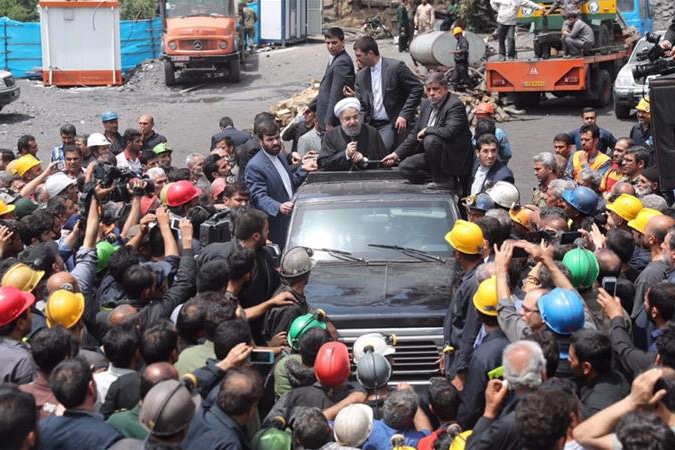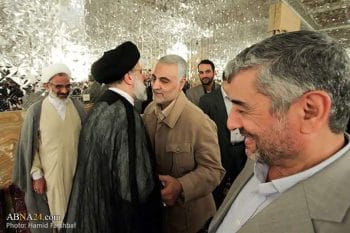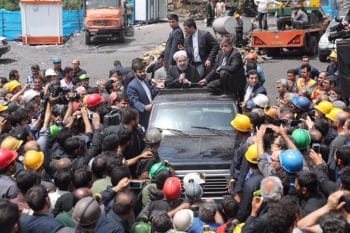UPDATE: Tehran’s mayor Mohammad Bagher Ghalibaf has dropped out of election, allowing “hardliners” to a coalesce around Raisi. Ghalibaf asked his supporters to vote for Raisi. Placeholder candidate Eshaq Jahangiri, a deputy to President Hassan Rouhani, has also dropped out of Iran’s presidential election days before the vote.
With a few days to go to Iran’s upcoming presidential elections on 19 May, six candidates could survive the vetting process of the Guardian Councils. Mohammad-Baqer Qalibaf, Mostafa Hashemi-Taba, Es’haq Jahangiri, Mostafa Mirsalim, Ebrahim Raisi and Hassan Rouhani are the “qualified” ones who have started their campaigns and have been allowed to define their plans and garner votes up until May 18th. The role of the media, both in Iran and throughout the diaspora, to shape public opinion is significant. Iranian state media, radio and television are supposed to give the “hopefuls” an opportunity to continue campaigning for office, as they speak about their future plans and defend past performances, but they often fall short.

The 6 approved candidates competing in Iran’s presidential election. Left to Right: Mostafa Hashemi-Taba, First VP Eshagh Jahangiri, President Hassan Rohani, “Hardline” cleric Ebrahim Raisi, Tehran mayor Mohammad Baqer Qalibaf and Mostafa Agha Mirsalim. (Source: Iranian daily Shargh)
The Pro-West Persian Media in the Diaspora
Meanwhile the Iranian media in the diaspora such as BBC Persian, VOA Persia (the Voice of America-Persian News Network,) Radio Farda (the Iranian branch of the U.S. government-funded Radio Free Europe/Radio Liberty) alongside a number of other pro-West Persian websites such as IranWire and Radio Zamaneh (an Amsterdam-based Persian language radio) are busy playing a role in the upcoming elections. Prominent among them is the role of BBC Persian in reinforcing the binary of lesser-of-two-evils politics in favor of the so-called moderate government of Hassan Rouhani. Along similar lines, the Western mainstream media tends to tout the idea that Iran’s ‘Deep State’ could unseat Rouhani with a Khamenei-backed “hard-liner” in the upcoming elections. What is at stake is how, this could have happened without the green light from Iran’s Supreme Leader, Ayatollah Ali Khamenei? How, could Rouhani and his campaign so actively utilized in the state’s all-powerful organ of propaganda, the Islamic Republic of Iran Broadcasting (IRIB)?
Iranian Workers’ is Now a Hashtag
The question of who won Iran’s presidential debates has been widely discussed in social media these days. A number of hashtags (mostly in Persian) strive to use the tools of communicative capitalism to influence the upcoming elections. The supporters of the current “moderate” president—a wide range of Iranians both in the country and the diaspora, from religious reformists to pro-West petite bourgeoisie forces, and those concerned citizens who are afraid of seeing “hardliners” in the office to provoke US warmongers against their country—are tweeting popular Persian hashtags such as “palpable changes” and “with Rouhani until 1400” (2021.) A boycott has also been proposed by “opposition” groups on the eve of the elections. A diverse range of forces in different sections of “regime changers” are active in this virtual “struggle;” from MEK and” Crown Prince” of Iran to the part of “Iran experts” in the service of hawkish American think tanks like “Foundation for Defense of Democracies.” The virtual fight of the signs and hashtags, “I will vote” versus “I won’t vote” keeps banalizing the question of political agency and reinforcing the notion of a supposed “Twitter Revolution.” Meanwhile, as Iranian workers continue to struggle for independent trade unions, the recent hashtag “tell me about syndicate” (#ازسندیکابگو) is barely able to go beyond expropriation and exploitation of communicative processes. Meanwhile, the absence of political parties and organizations, reinforces communicative capitalism: the circulation and foreclosure of politics, are among the causes of a divided left in Iran today. The different sections of Iran’s left are busy maintaining their own agency, in or outside of slacktivists club, for or against the electoral liberal democracy.
During the debate, Iranian news sites and channels on the smartphone app Telegram were highly active, and engaging in “fact-checking.” A large number of middle class Iranians are also highly active on Twitter to reinforce the binary of Rouhani versus Raisi/Ghalibaf. They argue that Iran’s ruling establishment is a mixture of democracy and oligarchy. By voting, citizens strengthen the “democratic” part of the government. By boycotting the elections, the “hardliners” can take hold of this “democratic” part and make irreversible changes. Using Silicon Valley’s favorite toys—as in the aftermath of 2009 elections—they have become a significant force in shaping both the “vote” and “boycott” tendencies in the virtual world. The difference between the 2009 elections and 2017 is that all the “qualified” candidates Rouhani, Ghalibaf, Mirsalim, Jahangiri and Raisi are also very active on social media, particularly Twitter. Nevertheless, an online poll indicated that First Vice President Eshaq Jahangiri has attracted national attention, taking a lead over his fellow competitor, incumbent Hassan Rouhani, who is running for a second term. Khamenei ‘s recent meeting with Jahangiri indicates his mediator role between the Deep State and the “Reformists,” whose relationships with Khamenei were tarnished after the 2009 unrest and the so-called Green Movement. Interestingly, this placeholder candidate is the head of the Resistance Economy Command Headquarters.
The Narrative of Iranian Liberals: Pro-FDI “Democracy” Promoters
What is at stake though is the disconnection of these seasonal political activists from social existence. Western “nice theories” about social media and the protests in Iran today has little basis in reality; in the aftermath of 2009 elections, it was mostly American, rather than Iranian, bloggers who were culpable for blowing the role of technology out of any reasonable proportion. The role of liberal native informants in this elections are remarkable. They use these technologies to leverage the ideological state apparatuses, as has been described by Louis Althusser, to engage in an imperial transnational politics in real time. The ways in which the liberal Iranian journalist of The Guardian and his counterparts in other Western mainstream media formulate the current upheavals is a clear example of the tendency of “overblowing the role of technology.” Saeed Kamali Dehghan’s narrative of the current situation in Iran is completely in line with the neoliberal forces within the government and a large part of the “opposition.” These forces are typically against a direct military intervention and economic sanctions while supporting foreign direct investment (FDI) and presenting “free market” economy as a prerequisite of “democracy” in Iran.
Meanwhile, poverty and inequality has been at the center of the 2017 presidential debates. While Ali Khamenei is still going on about “self-sufficiency” and the “Resistance Economics,” Iranian authorities have adopted a comprehensive strategy encompassing market-based reforms, as reflected in the government’s 20-year vision document and the sixth five-year development plan for the 2016-2021 period.
What Remains of “the Green Movement?”
In the lead up to this election, there has been barely any discussion in the mainstream media about Iran’s ‘resistance economy’ which is drying out in neoliberal rehab; however, the discussion of the legitimacy of the 2009 People’s Movement, a.k.a “the Green Movement,” as a homegrown, indigenous, democratic movement within Iran continues. The symbolic leaders of the Green Movement are still under house arrest—their continuing resistance fueling the material for the human rights industrial complex in the West. Many of those who believe “the Green Movement,” is still alive and well, line up behind Rouhani’s neoliberal forces against Raisi/Ghalibaf. Meanwhile, the unprecedented flexibility of the regime to let the known liberal political dissident and former political prisoner like Abdollah Momeni and other controversial civil rights activists and journalists such as Yashar Soltani and Leila Arshad run in Iran’s upcoming city council elections, which are to be held concurrently with the May 19 presidential vote is substantial. However, the potential possibility of “disqualifying” these candidates has still a great chance, if nothing happens, for the first time the civil rights activists, journalists and pro-West student activists who were very active in the liberal wing of Iran’s opposition will be allowed to run for the Tehran City Council which elects the Tehran mayor. The Tehran municipality is the largest, most wealthy and influential municipality in the country; Tehran mayors from pro-moderate Gholamhossein Karbaschi, who is supporting Rouhani in this election, to the current mayor Mohammad Bagher Ghalibaf, who is one of the “hardliner” presidential candidates, all have been the representatives of neoliberalization of the city. Economic policy and development issues have dominated Iranian urban activists’ concerns because they have been implicated in the rise of poverty, especially of women, in Tehran. The increases in child labor and homelessness are the fruits of Structural Adjustment Programmes (SAPs) in the post Iran-Iraq war era. Extracting value from the capital by both “moderate” and “hardliner” mayors, neoliberal urban planning policies and real estate in the capital of Iran, has been at the center of the discussions in recent years. Tehran is changing quickly and intensely, causing profound changes to the city’s structure. According to Hossein Raghfar, an economist at Al Zahra University, the process of neoliberalization is going to make Tehran another São Paulo. São Paulo has been pursuing neoliberal practices that generate social and urban fragmentation.
Commodification of The Legacy of the Fallen Anti-Capitalist Heroes in the Race
Meanwhile, Major General Qasem Soleimani, an Iranian senior military officer and a key political actor in the Islamic Revolutionary Guard Corps (IRGC) met with Ebrahim Raisi, the powerful Iranian cleric. Some believe that a presidential run by Raisi is intended to create a track record for him in time for the selection of the next Supreme Leader. His weak performance in the debate called these assumptions into question. Meanwhile, in an official statement, Iran’s former President Mahmoud Ahmadinejad—who has been disqualified from running in the upcoming election—has declared that he does not favor either candidate. Some believe that the ‘Deep State’—the secret and semi-secret networks of military, security and intelligence forces that support Khamenei—still needs a “moderate” government to protect itself from crusading warmongers on Capitol Hill. However, given the severe economic hardship and the demagogic election rhetoric of “hardliners,” the election may reach a second round.
Regardless of who makes it out to the ballot box, the elections are not the end of the game for the political actors like Raisi, as he is an important representative of parasitic finance capital in Iran. He is the custodian of Astan Quds Razavi, the wealthiest charity in the Muslim world and the organization in charge of Iran’s holiest Shi’ite Muslim shrine in the northeastern city of Mashhad. He was a key member of the “death committee,” which oversaw executed thousands of anti-capitalist political prisoners in Iran in 1988. Having said that—and contrary to the mainstream narrative of pro-“Moderate” forces who want us to share a historical amnesia—one should not forget that Rouhani has since the 1979 revolution enjoyed a close relationship with the ultraconservative security forces. For example, he was the right-hand man of former Iranian president Ali Akbar Hashemi Rafsanjani’s, commanding Iran’s forces during the Iran-Iraq War of the 1980s; and was actively involved in the crackdown of the 1999 student uprising as secretariat of the Supreme National Security Council. Along similar lines, the recent “anticipations” of Hassan Rouhani’s “moderate” minister of intelligence Mahmoud Alavi connects the dots. Alavi recently said, “regrettably, the remains of Socialist ideas and a hatred of Capitalism more or less continue to exist in our society.” Yet the legacy of the fallen anti-capitalist heroes of the 1980s has become a commodity in the hands of pro-Rouhani forces against their political rival Ebrahim Raisi.
Furious Miners Beat on Rouhani armored SUV

Protests emerged in Golestan province where at least 26 miners were killed in an explosion on May 3, 2017.
Iranian labor enjoyed a brief moment of freedom during the revolutionary period in 1979. Most of the leading members of the worker’s councils were members (or sympathizers) of different political organizations. The most influential in the council movement, was the Fadayeen. Originating as a guerrilla organization during the time of the Shah, the Fadayeen soon split into several different Fadaee groups. There was also the Tudeh Party of Iran (the Communist Party), Workers Path, and a multitude of Maoist organizations. The activities of these revolutionary forces were soon officially liquidated and banned by the emergence of “Islamic Labor Councils” which were instituted under the sponsorship of the new theocratic government. More than three decades after the bloody repression of those who were dreaming of a powerful anti-imperialist trade union movement in Iran, the seventeen Iranian gold miners—who were sentenced to 100 lashes for protesting their sudden lay-offs in May 2016—were not able to meet political subjectivity and were immediately co-opted by the Western mainstream media and the “left” and right slacktivists on social media.
Yet, the reality is that coal and privatization carry a heavy human cost: one need look no further than the tragic death of a dozens of miners in the northern province of Golestan. The mining disaster was not able to shed light on the current economic policies of the candidates in Iran. However, on the one hand it has become the martial of presidential candidates against one another and on the other hand, the subjects of the pathetic attempts of their pro-West rivals in exile. Ahead of another election, Iranian liberals at different American think tanks have been striving to meet the insatiable interest of the West in its dispute with the current neoliberal bureaucracy in Iran;they mostly line up behind President Rouhani’s forces.
“The devastated miners cannot live with Rouhani’s hollow promises,” was only one of many comments on a moving video of the disaster. (Also see “Iranian Labor and the Struggle for Independent Unions,” by Sohrab Behdad and Farhad Nomani, Frontline, April 18th, 2011)
The video shows a recent encounter of the desperate Iranian miners with Hasan Ruhani, as part of Rouhani’s attempt to win a second term. During his visit to the site of the mining disaster, furious miners beat on his armored SUV and shouted at him. Contrary to the account of ex-BBC and current Reuters reporter, Bozorgmehr Sharafedin—which mirrored that of most other pro-West Iranian journalists—it was not only “Rouhani’s conservative rivals” who shared the video far and wide on social media, supposedly to undermine his “landmark nuclear deal.” Moving images with the similar comments have also been posted by a number of other independent observers and activists on social media with the keywords: work, safety, mining, neoliberalism, deregulation, short-term contract, free trade, and privatization of mining industry.
The extensive coverage by Maydan—an independent online venue in Iran which has been focusing on the ongoing neoliberalization of minds, urban spaces, and bodies in the country—was barely able to counteract the toxic narrative of the western mainstream media of recent coal mining disaster. Hence, the buried Iranian miners have been buried a second time by political maneuvering of the different political factions ahead of another election. While the International Monetary Fund (IMF) this year applauded Iran’s “impressive recovery,” neoliberal economist and Rouhani supporter Saeed Laylaz—who’s been a frequent guest pundit on the liberal Western venues—told Reuters that, “all the positive results of the nuclear deal and lifting of sanctions have been overshadowed by the low prices of oil.”
Regardless of the election results, it will not be difficult to identify the real winners and losers of the 2017 elections. As a matter of fact, the transformation of the Iranian state is linked to the context of globalized frames of neo-liberal capitalism and contemporary schemes of Islamic politics. That said, whether the unhappy marriage of parasitic finance capital and the military bureaucratic bourgeoisie bring “democracy” to Iranian middle class, the users of Silicon Valley’s favorite toys, remains an entirely open question.



